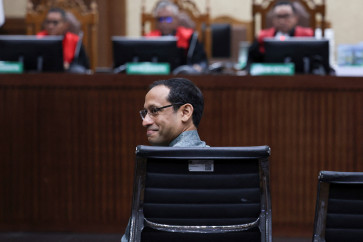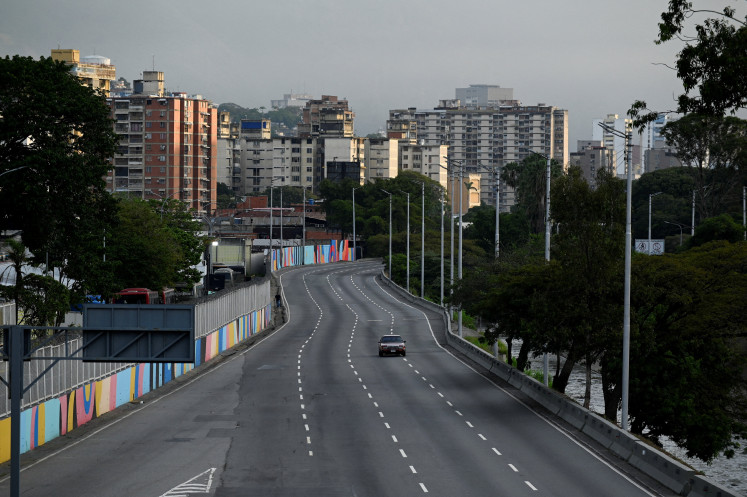Popular Reads
Top Results
Can't find what you're looking for?
View all search resultsPopular Reads
Top Results
Can't find what you're looking for?
View all search resultsA celebration of pluralism in Banyuwangi
Dance fever: Performers at the annual Kuwung Festival, just one item in the cityâs calendar of events
Change text size
Gift Premium Articles
to Anyone
Dance fever: Performers at the annual Kuwung Festival, just one item in the city's calendar of events.
US Ambassador to Indonesia Robert Blake celebrated for the first time Thanksgiving Day with members of the Osing ethnic group in Banyuwangi, East Java, as part of a visit in November.
The visit also marked the International Day for Tolerance, which reaffirms human rights.
Apart from being entertained by traditional dances and typical Osing cuisine, Blake also released young turtles on Boom Beach. 'I'm happy to be able to celebrate Thanksgiving in Banyuwangi. This will hopefully strengthen inter-national and interfaith harmony, as well as a mutual appreciation of differences,' he said.
Decades ago, Banyuwangi was only a minor regency at the eastern tip of Java serving as a transit point for tourists going to Bali. In the 1990s, Banyuwangi was notorious for its black magic practices and protests against the regent.
At present, however, Banyuwangi is the only city in Indonesia that has received the Charter for Compassion from the Compassion Action International for its appreciation of the values of compassion, humanism and pluralism.
With the charter, Banyuwangi is one of 40 'cities of compassion', according to the organization.
'The appreciation of pluralism in Indonesia is perpetuated in the Constitution of the state, and this is clearly noticed in Banyuwangi, where Osing culture and traditions are preserved, recognized and observed,' Blake said, as conveyed by US Consul General Joaquin F. Monseratte.
The Osing settled in the region at the end of the Majapahit Empire, when the Blambangan kingdom fought for two centuries to maintain its independence.
The struggle for power led to population migration, a change in capital and the emergence of new settlements.
People moved to places such as the slopes of Mount Bromo (settled by the Tengger), Bali and Banyuwangi. Those remaining in Banyuwangi, however, began to be known as the Osing.
Osing means 'no'. When asked if they were Balinese or Javanese, they used to answer 'Osing'.
In later periods, the Osing, assimilated through marriages with the other ethnic groups, such as the Javanese, Madurese and Bugis.
The community's values of compassion, humanism and pluralism, said Banyuwangi Regent Abdullah Azwar Anas, had been nurtured by the Osing community to build the city of Banyuwangi.
'While many people were originally ashamed of acknowledging their city due to the 'black magic' image, now they are engaged in a moral movement,' he revealed.
'We've finally incorporated the moral assets of the Osing community into an event called the Kuwung Festival. It's a program to appreciate the values of compassion, humanism and pluralism.'
The Kuwung Festival features traditional art performances of the local community. Kuwung means 'rainbow', depicting the reality that the Banyuwangi population is characterized by diversity in ethnicity, language and religion.
While Kuwung Festival was previously held in the daytime, on December 13, 2014 it took place in the evening under the theme Gumelare Cindhe Sutra (Spreading the Silk Mat of Banyuwangi), portraying the cultural life of Osing people from childhood to adulthood.
Showtime: Performers and dancers of the Kuwung Festival, which was given the theme Gumelare Cindhe Sutra, or Spreading the Silk Mat of Banyuwangi, presented pieces showing the cultural life of Osing people from childhood to adulthood.
Each theatrical fragment was rendered by dancers with traditional music accompaniment. There were dance compositions telling the stories of local people's lives as children, adolescents and adults.
Other arts presented at the festival included a children's horse dance, a circumcision ritual, a mythical dance titled Barong Ider Bumi, a chanting dance titled Hadrah Kuntulan, traditional wedding ceremonies and a barongsai lion dance.
'This festival was entirely prepared by the people in Banyuwangi. The government didn't invite an event organizer to arrange this event. Through this program, local citizens can learn how to organize a cultural festival that appeals to visitors,' Anas said.
Lil' dancers: Children perform at the Kuwung Festival. Here was also a children's horse dance, a circumcision ritual and a barongsai lion dance.
It joins several other events on the city's event calendar, such as the Banyuwangi Ethno Carnival, Banyuwangi Beach Jazz and the Gandrung Sewu Art Festival.
A member of the Blambangan Art Council of Banyuwangi, Hasan Basri, said that the cultural festivals constituted an effort to preserve Osing culture. 'The Osing language of the Banyuwangi has become a multiethnic tongue spoken also by those of Javanese, Balinese and Madura origin living in Banyuwangi,' he added.
As Jakartans are called Anak Betawi and Surabaya citizens Arek Suroboyo, Banyuwangi residents are popularly addressed as Lare Osing. Whether they are Osing or only speak the Osing language, they remain proud of their ties to Banyuwangi.
'In their hearts they will say, 'Isun Lare Osing!' [I'm an Osing],' Hasan said.
Let's get the party started: Men bear woman performer on a palanquin at the Kuwung Festival.
- Photos by JP/Indra Harsaputra














